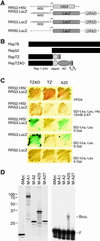A genetic screen identifies a cellular regulator of adeno-associated virus
- PMID: 11734633
- PMCID: PMC64971
- DOI: 10.1073/pnas.261567198
A genetic screen identifies a cellular regulator of adeno-associated virus
Abstract
Adeno-associated virus type 2 (AAV2) is a human parvovirus that has attracted attention as a vector for gene transfer. Replication and site-specific integration of the wild-type virus requires binding of the AAV2 Rep proteins to a cis-regulatory element named the Rep recognition sequence (RRS). RRS motifs are found within the cellular AAVS1 integration locus, the viral p5 promoter, and the inverted terminal repeats (ITRs). Here we report the design of a genetic screen based on the yeast one-hybrid assay to identify cellular RRS-binding proteins. We show that the human zinc finger 5 protein (ZF5) binds specifically to RRS motifs in vitro and in vivo. ZF5 is a highly conserved and ubiquitously expressed transcription factor that contains five C-terminal zinc fingers and an N-terminal POZ domain. Ectopic expression of ZF5 leads to an ITR-dependent repression of the autologous p5 promoter and reduces both AAV2 replication and the production of recombinant AAV2. By using deletion and substitution mutants we show that two different domains of ZF5 contribute to AAV2 repression. Negative regulation of the p5 promoter requires the POZ domain, whereas viral replication is inhibited by the zinc finger domain, likely by competing with Rep for binding to the ITR. Identification and characterization of proteins that bind the ITR, the only viral genetic element retained in AAV2 vectors, will lead to new insights into the unique life cycle of AAV2 and will suggest improvements important for its application as a gene therapy vector.
Figures





References
-
- Berns K I. In: Virology. Fields B N, Knipe D M, Howley P M, editors. Vol. 2. Philadelphia: Lippincott-Raven; 1996. pp. 2173–2197.
Publication types
MeSH terms
Substances
LinkOut - more resources
Full Text Sources
Miscellaneous

